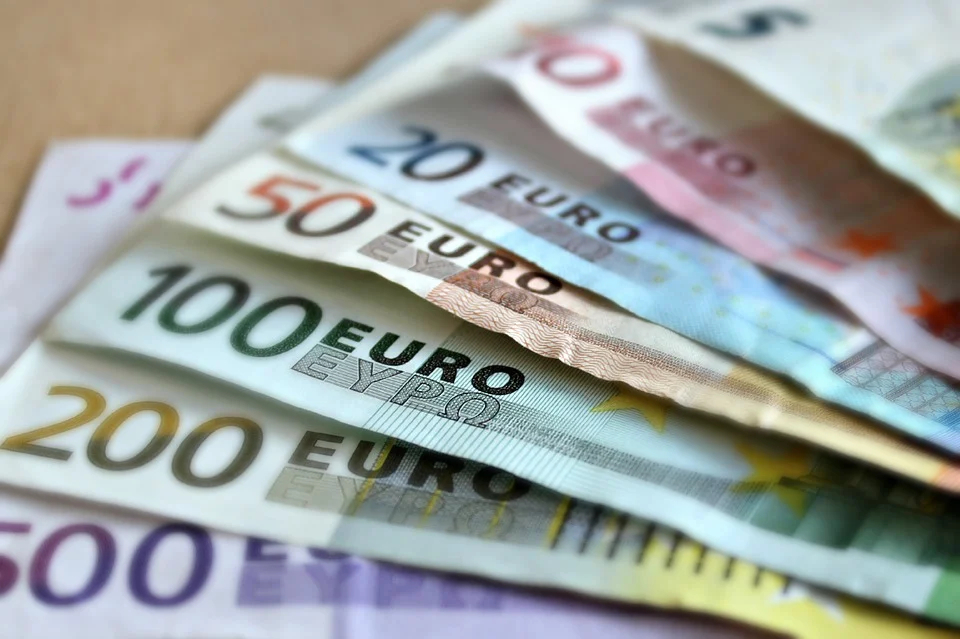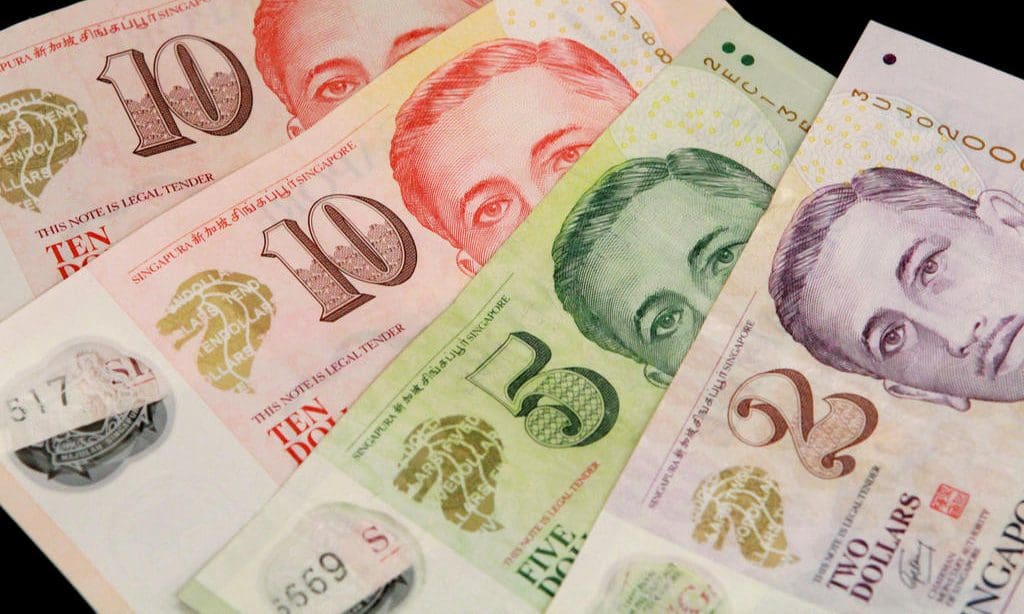Trading EUR/SGD



The EUR/SGD is an exotic forex pair with an interesting history. While the Euro is the official currency of 19 member states of the European Union, the Singapore Dollar is controlled by the country’s central bank and is one of the most stable currencies in the world.
In this tutorial, we review the advantages and disadvantages of trading EUR/SGD, investing strategies, plus key events that influence the forex pair’s exchange rate. We have also compiled a list of the best EUR/SGD brokers below.
Best EUR/SGD Brokers
Our evaluations have revealed these 6 brokers as the best for trading EUR/SGD:
Here is a short overview of each broker's pros and cons
- FOREX.com - Founded in 1999, FOREX.com is now part of StoneX, a financial services organization serving over one million customers worldwide. Regulated in the US, UK, EU, Australia and beyond, the broker offers thousands of markets, not just forex, and provides excellent pricing on cutting-edge platforms.
- IC Markets - IC Markets is a globally recognized forex and CFD broker known for its excellent pricing, comprehensive range of trading instruments, and premium trading technology. Founded in 2007 and headquartered in Australia, the brokerage is regulated by the ASIC, CySEC and FSA, and has attracted more than 180,000 clients from over 200 countries.
- XM - XM is a globally recognized forex and CFD broker with 15+ million clients in 190+ countries. Since 2009, this trusted broker has been delivering low trading fees across its growing roster of 1000+ instruments. It’s also highly regulated, including by ASIC, CySEC and DFSA and SCA in the UAE, and offers a comprehensive MetaTrader experience.
- Pepperstone - Established in Australia in 2010, Pepperstone is a top-rated forex and CFD broker with over 400,000 clients worldwide. It offers access to 1,300+ instruments on leading platforms MT4, MT5, cTrader and TradingView, maintaining low, transparent fees. Pepperstone is also regulated by trusted authorities like the FCA, ASIC, and CySEC, ensuring a secure environment for day traders at all levels.
- Fusion Markets - Fusion Markets is an online broker established in 2017 and regulated by the ASIC, VFSC and FSA. It is best known for its low-cost forex and CFD trading, although its multiple account types and copy trading solutions cater to a range of traders. New clients can sign up and start trading in 3 easy steps.
- BlackBull - BlackBull is a New Zealand-based CFD broker providing diverse trading opportunities on over 26,000 instruments. After undergoing a rebrand in 2023, it now sports a modern look and feel complete with professional-grade trading tools and ultra-fast execution speeds averaging 20ms.
FOREX.com
"FOREX.com remains a best-in-class brokerage for active forex traders of all experience levels, with over 80 currency pairs, tight spreads from 0.0 pips and low commissions. The powerful charting platforms collectively offer over 100 technical indicators, as well as extensive research tools."
Christian Harris, Reviewer
FOREX.com Quick Facts
| Demo Account | Yes |
|---|---|
| Instruments | Forex, Stock CFDs, Futures, Futures Options |
| Regulator | NFA, CFTC |
| Platforms | WebTrader, Mobile, MT4, MT5, TradingView |
| Minimum Deposit | $100 |
| Minimum Trade | 0.01 Lots |
| Leverage | 1:50 |
| Account Currencies | USD, EUR, GBP, CAD, AUD, JPY, CHF, PLN |
| Currency Pairs | USD/CNH, EUR/CNH, AUD/CNH, CNH/JPY, EUR/AUD, EUR/SGD, EUR/TRY, EUR/CAD, EUR/GBP, GBP/AUD, GBP/CAD, GBP/JPY, GBP/ZAR, USD/HKD, USD/SGD, USD/THB |
Pros
- FOREX.com offers industry-leading forex pricing starting from 0.0 pips, alongside competitive cashback rebates of up to 15% for serious day traders.
- There’s a wealth of educational resources including tutorials, webinars, and a stacked YouTube channel to help you get educated in the financial markets.
- The in-house Web Trader continues to shine as one of the best-designed platforms for aspiring day traders with a slick design and over 80 technical indicators for market analysis.
Cons
- Funding options are limited compared to leading alternatives like IC Markets and don’t include many popular e-wallets, notably UnionPay and POLi.
- FOREX.com's MT4 platform offers approximately 600 instruments, significantly fewer than the over 5,500 available on its non-MetaTrader platforms.
- Demo accounts are frustratingly time-limited to 90 days, which doesn’t give you enough time to test day trading strategies effectively.
IC Markets
"IC Markets offers superior pricing, exceptionally fast execution and seamless deposits. The introduction of advanced charting platforms, notably TradingView, and the Raw Trader Plus account, ensures it remains a top choice for intermediate to advanced day traders."
Christian Harris, Reviewer
IC Markets Quick Facts
| Demo Account | Yes |
|---|---|
| Instruments | CFDs, Forex, Stocks, Indices, Commodities, Bonds, Futures, Crypto |
| Regulator | ASIC, CySEC, CMA, FSA |
| Platforms | MT4, MT5, cTrader, TradingView, TradingCentral, DupliTrade, Quantower |
| Minimum Deposit | $200 |
| Minimum Trade | 0.01 Lots |
| Leverage | 1:30 (ASIC & CySEC), 1:500 (FSA), 1:1000 (Global) |
| Account Currencies | USD, EUR, GBP, CAD, AUD, NZD, JPY, CHF, HKD, SGD |
| Currency Pairs | USD/CHF, USD/JPY, USD/CNH, EUR/AUD, EUR/SGD, EUR/TRY, EUR/CAD, EUR/GBP, GBP/AUD, GBP/CAD, GBP/JPY, USD/HKD, USD/SGD, USD/THB |
Pros
- IC Markets offers among the tightest spreads in the industry, with 0.0-pip spreads on major currency pairs, making it especially cost-effective for day traders.
- IC Markets secured DayTrading.com's 'Best MT4/MT5 Broker' in 2025 for its seamless, industry-leading MetaTrader integration, refined over years to maximize the platform experience.
- You have access to over 2,250 CFDs across various markets, including forex, commodities, indices, stocks, bonds, and cryptocurrencies, allowing for diversified trading strategies.
Cons
- Interest isn't paid on unused cash, an increasingly popular feature found at alternatives like Interactive Brokers.
- While IC Markets offers a selection of metals and cryptos for trading via CFDs, the range is not as extensive as brokers like eToro, limiting opportunities for traders interested in these asset classes.
- There are fees for certain withdrawal methods, including a $20 wire charge, which can eat into profits, especially for frequent withdrawals.
XM
"With a low $5 minimum deposit, advanced charting platforms in MT4 and MT5, expanding range of markets, and a Zero account offering spreads from 0.0, XM provides all the essentials for active traders, even earning our ‘Best MT4/MT5 Broker’ award in recent years."
Christian Harris, Reviewer
XM Quick Facts
| Demo Account | Yes |
|---|---|
| Instruments | CFDs, Forex, Stocks, Commodities, Indices, Thematic Indices, Precious Metals, Energies |
| Regulator | CySEC, DFSA, SCA, IFSC |
| Platforms | MT4, MT5, TradingCentral |
| Minimum Deposit | $5 |
| Minimum Trade | 0.01 Lots |
| Leverage | 1:1000 |
| Account Currencies | USD, EUR, GBP, JPY |
| Currency Pairs | USD/CHF, EUR/AUD, EUR/JPY, EUR/SGD, EUR/TRY, EUR/CAD, EUR/GBP, GBP/AUD, GBP/CAD, GBP/JPY, NZD/SGD, USD/HKD, USD/SGD |
Pros
- XM’s Zero account is ideal for day trading with spreads from 0.0 pips, 99.35% of orders executed in <1 second, and no requotes or rejections.
- XM has rolled out platform upgrades with integrated TradingView charts and an XM AI assistant, delivering faster execution, smarter analysis, and a sleeker, more intuitive trading experience.
- XM’s customer support has delivered over years of testing, with 24/5 assistance in 25 languages, response times of under 2 minutes and a growing Telegram channel.
Cons
- XM relies solely on the MetaTrader platforms for desktop trading, so there’s no in-house downloadable or web-accessible solution for a more beginner-friendly user experience with unique features.
- While the XM app stands out for its usability and exclusive copy trading products, the selection of technical analysis tools needs to be improved to meet the needs of advanced traders.
- XM is falling behind the curve by not offering cTrader and TradingView which are increasingly being favored over MetaTrader for their smoother user experience and superior charting packages.
Pepperstone
"Pepperstone stands out as a top choice for day trading, offering razor-sharp spreads, ultra-fast execution, and advanced charting platforms for experienced traders. New traders are also welcomed with no minimum deposit, extensive educational resources, and exceptional 24/7 support."
Christian Harris, Reviewer
Pepperstone Quick Facts
| Demo Account | Yes |
|---|---|
| Instruments | CFDs, Forex, Currency Indices, Stocks, Indices, Commodities, ETFs, Crypto, Spread Betting |
| Regulator | FCA, ASIC, CySEC, DFSA, CMA, BaFin, SCB |
| Platforms | MT4, MT5, cTrader, TradingView, AutoChartist, DupliTrade, Quantower |
| Minimum Deposit | $0 |
| Minimum Trade | 0.01 Lots |
| Leverage | 1:30 (Retail), 1:500 (Pro) |
| Account Currencies | USD, EUR, GBP, CAD, AUD, NZD, JPY, CHF, HKD, SGD |
| Currency Pairs | USD/CHF, USD/JPY, USD/CNH, EUR/CNH, GBP/CNH, NZD/CNH, EUR/AUD, EUR/SGD, EUR/TRY, EUR/CAD, EUR/GBP, GBP/AUD, GBP/CAD, GBP/HUF, GBP/JPY, NZD/SGD, USD/HKD, USD/INR, USD/SGD, USD/THB |
Pros
- There’s support for a range of industry-leading charting platforms including MT4, MT5, TradingView, and cTrader, catering to various short-term trading styles, including algo trading.
- Pepperstone has greatly improved the deposit and withdrawal experience in recent years, adding Apple Pay and Google Pay in 2025, as well as PIX and SPEI for clients in Brazil and Mexico in 2024.
- Pepperstone has scooped multiple DayTrading.com annual awards over the years, most recently 'Best Overall Broker' in 2025 and 'Best Forex Broker' runner up in 2025.
Cons
- Despite enhancements to its range of markets, crypto offerings are relatively limited compared to other brokers who focus on this area, with no option to invest in real coins.
- Pepperstone does not support cTrader Copy, a popular copy trading feature built into the excellent cTrader platform and available at alternatives like IC Markets, though it has introduced an intuitive copy trading app.
- Pepperstone’s demo accounts are active for only 30 days, which may not be not long enough to familiarize yourself with the different platforms and test trading strategies.
Fusion Markets
"Fusion Markets is a standout option for forex traders looking for excellent pricing with spreads near zero, industry-low commissions and recently TradingView integration. It’s a particularly good broker for Australian traders where the company is headquartered and regulated by the ASIC."
Jemma Grist, Reviewer
Fusion Markets Quick Facts
| Demo Account | Yes |
|---|---|
| Instruments | CFDs, Forex, Stocks, Indices, Commodities, Crypto |
| Regulator | ASIC, VFSC, FSA |
| Platforms | MT4, MT5, cTrader, TradingView, DupliTrade |
| Minimum Deposit | $0 |
| Minimum Trade | 0.01 Lots |
| Leverage | 1:500 |
| Account Currencies | USD, EUR, GBP, CAD, AUD, NZD, JPY, CHF, HKD, SGD |
| Currency Pairs | USD/CHF, USD/CNH, EUR/AUD, EUR/JPY, EUR/SGD, EUR/CAD, EUR/GBP, GBP/AUD, GBP/CAD, GBP/HUF, GBP/JPY, GBP/ZAR, NZD/SGD, USD/HKD, USD/INR, USD/SGD, USD/THB |
Pros
- The range of charting platforms and social trading features is excellent, with MT4, MT5, cTrader and more recently TradingView, catering to a wide range of trader preferences.
- Fusion Markets offers best-in-class support with very fast, friendly and helpful responses during tests and no frustrating automated chatbot to navigate.
- Fusion Markets is set up to support algo traders with a sponsored VPS solution and a 25% discount if you opt for the NYC Servers VPS for MT4 or cTrader.
Cons
- Traders outside of Australia must sign up with weakly regulated global entities with limited safeguards and no negative balance protection.
- Fusion Market trails alternatives, notably IG, in the education department with limited guides and live video sessions to upskill new traders.
- There is no proprietary trading platform or app built with beginners in mind, a notable drawback compared to AvaTrade.
BlackBull
"After improving its trading infrastructure with Equinix servers in New York, London, and Tokyo, reducing latency for traders, BlackBull is an obvious choice if you want to day trade stock CFDs with ECN pricing."
Christian Harris, Reviewer
BlackBull Quick Facts
| Demo Account | Yes |
|---|---|
| Instruments | CFDs, Stocks, Indices, Commodities, Futures, Crypto |
| Regulator | FMA, FSA |
| Platforms | BlackBull Invest, BlackBull CopyTrader, MT4, MT5, cTrader, TradingView, AutoChartist |
| Minimum Deposit | $0 |
| Minimum Trade | 0.01 Lots |
| Leverage | 1:500 |
| Account Currencies | USD, EUR, GBP, CAD, AUD, NZD, JPY, ZAR, SGD |
| Currency Pairs | EUR/AUD, EUR/JPY, EUR/SGD, EUR/CAD, EUR/GBP, GBP/AUD, GBP/CAD, GBP/JPY, GBP/ZAR, NZD/SGD, USD/SGD |
Pros
- After partnering with ZuluTrade and Myfxbook, alongside improvements to its own CopyTrader, and finally enabling cTrader Copy, BlackBull offers one of the most comprehensive copy trading experiences we've seen.
- BlackBull offers every ingredient for day traders; fast execution speeds of <100ms, leverage up to 1:500, and tight spreads from 0.0 pips.
- With three ECN-powered accounts (Standard, Prime, and Institutional), BlackBull accommodates beginners, experienced traders, and professionals, offering flexibility based on trading needs and capital.
Cons
- Unlike most top brokers, BlackBull charges an irritating $5 withdrawal fee, which can detract from the overall cost-effectiveness, especially for active traders who frequently move funds.
- Despite a growing selection of 26,000+ assets, including additions to its Asia Pacific indices, they are mainly stocks with an average selection of currency pairs and indices.
- BlackBull lacks a proprietary platform, relying on MetaTrader, cTrader and TradingView. While these are excellent, other brokers' exclusive platforms, notably eToro’s, often have unique features for beginner traders.
Live Chart
Note, the EUR/SGD live chart shows the current Euro to SGD conversion rate.
EUR/SGD Explained
EUR/SGD is defined as exotic because it is a large currency (the Euro) paired with the currency of a smaller economy (Singapore). The exchange rate represents how much of the quote currency, the Singapore Dollar, is needed to get one unit of the base currency, the Euro. Another way to put it is the amount of Singapore Dollars that you would receive for a conversion of 1 Euro to SGD. SGD to EUR would show the inverse.
Graphs and exchange rate tools for EUR/SGD can be found on currency converter websites such as XE. Simpler websites such as Coinmill also provide current conversion rates for 1 EUR into SGD.
The EUR/SGD pair set an all-time high of 2.23 in December 2004 and an all-time low of 1.43 in April 2015.
Why Trade EUR/SGD?
There are several reasons why investing in EUR/SGD is a good option:
- Potential profits – While the Singapore Dollar is a stable currency with a long-term growth trend, the Euro is more volatile, so the EUR/SGD offers interesting dynamics for traders with a decent risk appetite.
- Economy knowledge – As this currency pair is often analyzed using fundamental analysis (evaluating external events and influences) rather than technical analysis (identifying trends and patterns based on historical data), a deep macroeconomic understanding of the EU and Singapore could provide a trading advantage. Because of this, exotic pairs like EUR vs. SGD can sometimes be easier to forecast than major forex pairs.
- Trading costs – Generally, forex has low trading costs compared with other instruments such as stocks and shares. Most brokers don’t charge a commission for investing in forex, making their money from spreads instead. With that said, spreads widen and costs increase during periods of unexpected volatility.
Risks Of Trading EUR/SGD
There are also disadvantages to investing in EUR/SGD:
- Technical analysis – Because there isn’t a direct correlation between the two currencies, EUR vs. SGD predictions are difficult and technical analysis is often complicated.
- Availability of information – There is less information available about the Singapore Dollar as it is not a major currency, making the EUR to SGD rate more difficult to forecast.
- Liquidity – EUR/SGD has less liquidity than major forex pairs such as EUR/USD. Liquidity can be translated as buying power.
- Wider spreads – Because of the reduced liquidity, forex trading platforms tend to charge more for exotic pairs.
EUR/SGD Trading Strategy
Below are key factors to consider when trading EUR/SGD:
Forex Brokers
To invest in EUR/SGD, the first thing you will need to do is set up a trading account. It is important to select a good broker here, and there are several things to consider:
- Regulation – Where is the broker regulated, and what standards do they comply with? Find out if your funds are protected, for example, if the broker becomes insolvent.
- Platform – Brokers may offer their own proprietary platforms or license other platforms such as MetaTrader 4. Check platform reviews to ensure they meet your investing and live charting needs, including suitable indicators to enable Euro versus SGD trend analysis.
- Spreads, commission, and additional fees – Brokers will often make money from spreads on forex, the difference between the EUR/SGD buy and sell price. These spreads can be fixed or variable. Check if spreads are competitive and if any additional fees apply, such as account charges or commissions. Note, ECN accounts tend to offer ultra-low spreads, while brokers with fixed spreads generally offer wider but more predictable fees.
- Demo account – Some firms offer a free demo account option. This is a great way to practice strategies with virtual funds before investing with a real account. Brokers often offer demo accounts that reflect the same environment as their live account, giving clients the opportunity to get familiar with the platform before depositing real funds.
- Withdrawal of money – Ensure you have easy access to funds. In particular, look out for long withdrawal times, minimum requirements, and fees.
For EUR/SGD trading in Singapore, among the most popular forex brokers are CMC, IG, and Oanda, all of whom are regulated by the Singapore Central Bank, MAS. However, a maximum forex leverage of 1:50 is offered due to Singapore regulations, which isn’t as high as can be found elsewhere.
Due to the relative stability of currency in comparison with equities, leverage is often used to increase potential profits. However, traders should also be aware of the risks involved with using leverage, which can increase losses as well as profits.
Risk Management
Ensure you have a strategy for how much you’re willing to risk on each trade. It is advised that traders keep this low to reduce losses; it is uncommon for successful investors, for example, to risk more than 2% of their total capital on a single trade.
Economic News
It is particularly important for the EUR/SGD FX pair that traders keep up to date with economic news. Many online resources offer regular updates for EUR/SGD, including Yahoo Finance, Google Finance, Channel News Asia, and the Financial Times.
Additionally, investors should be aware of when key financial reports are released to react accordingly. Refer to the rest of this article to understand specific factors that influence the Euro and Singapore Dollar and key dates to look out for.
EUR/SGD Timing
The best time of day to trade is generally considered to be 1 pm – 5 pm GMT, as this is when both the London and New York markets are open. These trading centers account for a huge proportion of forex trades, meaning that there is more liquidity in the market at this time. This usually results in tighter spreads, allowing for investing at a better price.
Forward rates should also be considered when trading EUR/SGD. Although ‘spot market’ refers to ‘on the spot’ investing, trades are executed on the settlement date. This is usually two business days after the agreement.
As a result, most brokers roll the position forward and charge a swap fee, an overnight interest rate. This means you will either earn a credit (if the long currency interest rate is higher than the short currency) or a debit (if the short currency interest rate is higher than the long). Triple swap rates are usually applied if investing on a Wednesday to account for the weekend after the two business days. Traders should keep an eye on EUR/SGD forward points, which are the points added to or subtracted from the FX rate to account for this.
Volatility
The volatility of an instrument determines how much potential profit or loss you could make. EUR/SGD is characterized by relatively minor fluctuations on charts and is more suited to medium-term trading strategies. The infrequent reporting from the Singapore Central bank compared with other central banks also supports this strategy.
Investors may, therefore, want to look at the history of the Euro vs. SGD, including historical exchange rate data forecasts. 5-year and 10-year EUR/SGD charts are good options for this analysis.
Euro Background
In this section, we look at the history of the Euro and key influences on its value to help you better understand how to forecast EUR/SGD.
The Euro was established by the Maastricht Treaty in 1992, where the original 12 member states created an economic union and associated currency. The Euro was issued in 1999 and is now the official currency of 19 of the 27 member states of the EU. The countries that have adopted the Euro are referred to as the Eurozone.

What Influences The Euro?
Individual Country Economies
Germany, France, Italy, and Spain combined represent three-quarters of the Eurozone’s GDP, with Germany and France accounting for over 40% alone. Investors should pay attention to these countries’ economies, in particular, when researching Euro performance. Keep on top of GDP, production, and unemployment rates.
Inflation
Inflation is a key factor for all currencies, with high inflation generally resulting in currency depreciation. The key measure of inflation in the Eurozone is the Consumer Price Index (CPI). This indicator calculates the price of a basket of goods and services likely to be purchased by an average household. Traders typically follow the Core CPI, which is the CPI but without energy and food. This is because energy and food prices are more volatile and can distort the CPI.
Sentiment Reports
One of the most widely followed reports is the monthly German ZEW Economic Sentiment. Up to 300 financial experts are interviewed about their expectations of the economy for the next six months, including exchange rates. From this, a single indicator is published, allowing for an easy-to-interpret outlook on the European economy, which is valuable when trading EUR/SGD.
Monetary Policy
The European Central Bank (ECB) has a large influence on the EUR, as it sets target interest rates and controls the supply of the Euro currency. Press conferences from the ECB often cause currency volatility, especially during the question period. With this in mind, review ECB announcements when online trading EUR/SGD.
GDP & Economic Growth
GDP and economic growth reports indicate the overall state of the Eurozone economy. GDP is a measure of the goods and services produced, so a high GDP is a positive sign for the Euro. As mentioned, Germany and France play the biggest role here.
Balance of Payments
The balance of payments for a country is made up of three accounts: current, financial, and capital. These provide a measure of its interaction with other countries, including income and trade.
A current account surplus means more exports than imports, which is positive for the currency. A current account deficit means the opposite. Again, it is worth focussing on the reports for Germany and France in particular.
Politics
The impact of politics on EUR to SGD has become especially relevant now. European Union politics and elections of key member states can have a large influence on the Euro. Keep up to date with trade deals and countries entering and leaving the EU, for example, the UK and Brexit.
Another important example is the Ukraine-Russia war. Even though Ukraine is not part of the EU, the conflict had a deep impact on the EUR/SGD price – the EUR weakened in face of the SGD.
Singapore Dollar Background
Singapore is a politically stable country with a small yet strong economy that attracts investors. Since the first prime minister was elected in 1959, there has been only one ruling party, the People’s Action Party (PAP).
Singapore is highly dependent on exports, including electronics, pharmaceuticals, and chemicals. This means the exchange rate has a much stronger influence from inflation versus interest rates. The Central Bank controls inflation through the Singapore Dollar.

The country has undergone massive economic growth since the introduction of the exchange rate system in 1981, mainly driven by the manufacturing industry. This has meant Singapore has rapidly developed from a low-income to a high-income country, despite the mid-80s recession and Asian financial crisis.
What Influences The SGD?
Monetary Policy & Economic Growth
The Singapore Central Bank (MAS) conducts monetary policy through exchange rate setting rather than interest rates. The MAS lets the Singapore Dollar rise or fall against a basket of currencies of major trading partners within a fixed band.
Each currency in the basket has a different weighting depending on the volume of trading with that country which is revised periodically to reflect the latest data. The band provides flexibility to accommodate short-term fluctuations. If the exchange rate falls outside the band, then MAS will buy or sell foreign exchange to guide the rate back into the band.
The aim is to promote price stability to generate economic growth. Because of this, volatility in the exchange rate is low. The standard deviation of the Singapore Dollar nominal effective exchange rate (S$NEER), which is a measure of variation, was 1.48% between Q1 81 and Q2 20, compared with 3.52% for the USD and 4.61% for JPY. The S$NEER has gained by 0.97% since mid-October 2021, and in April 2022, it has been recorded near the upper limit of the policy band.
Overall, the Singapore Dollar has seen a long-term appreciation trend due to economic progression and high current account surpluses. This is a key reason why many investors choose to sell EUR and buy SGD.
EUR/SGD Key Dates
Below are the key dates to be aware of when trading EUR/SGD, based on the external factors that influence this forex pair.
MAS policy announcements are usually released in April and October each year. This is less frequent than typical reporting from central banks, meaning EUR/SGD is arguably suited to longer-term trading strategies.
The Europe CPI report is released monthly, with flash estimates released at the end of the month and the official CPI released two weeks later. The effects of the flash report often dilute the EUR/SGD exchange rate impact of the official report.
The Eurozone GDP report is released approximately two months after the end of each quarter. Analysts usually estimate GDP prior to this, though the release of the report still tends to have an impact on the Euro, especially when results are different from predictions.
The Singapore current account balance is released approximately two months after the end of each quarter. The Euro current account report is released monthly, usually during the second week of each month.
EUR/SGD Correlation
The Euro and Singapore Dollar aren’t highly correlated, as the EU is not one of Singapore’s top export destinations. However, traders should be aware of relationships with other currencies.
The EUR/SGD rate is highly positively correlated with EUR/USD. This means that when EUR/USD increases, the EUR to SGD exchange rate is also likely to increase. Plotting EUR/USD and EUR/SGD on a live chart shows this clearly. This is because Singapore is highly influenced by exports to the US.
The EUR against SGD is also positively correlated with EUR/JPY due to a trading agreement that has resulted in a high level of imports and exports between Singapore and Japan.
Final Word On Trading EUR/SGD
EUR/SGD is a forex pair that is difficult to predict using technical analysis and, for this reason, is more suited to experienced traders. However, having a deep understanding of both economies and their influencing factors is valuable. Though EUR/SGD has a long-term declining trend due to Singapore’s economic growth, the Euro volatility means profits are possible in the short term.
While the EUR/SGD 2025 outlook is more difficult due to the effects of the war in Ukraine on both economies, this may open up opportunities for traders.
FAQs
What Is The Conversion Rate For 1 EUR In SGD?
The Euro to Singapore Dollar conversion rate moves continuously. Refer to a live chart to convert 1 EUR into Singapore Dollars.
What Is The Trend History Of The Euro Vs. The SGD?
Overall, the Euro versus SGD has seen a long-term declining trend due to Singapore’s advancing economy and the Eurozone’s decrease in GDP growth. Events such as the Asian financial crisis, Russian-Ukrainian war, and higher inflation rates in the EU are responsible for fluctuations within this overall trend.
Should I Invest In EUR/SGD?
EUR/SGD is an exotic forex pair suited to more experienced traders. It is important to understand the events that influence both the European and Singapore economies before trading this FX pair. See our guide for more information.
What Affects The EUR Vs. SGD Rate?
The EU and Singapore central bank monetary policies both affect the Euro to SGD rate. The Euro is also subject to greater political influence from EU member states, unlike Singapore, which has a more stable political background.
How Can I Trade EUR/SGD?
Investors will need to open a trading account with a forex trading platform that offers the EUR/SGD currency pair. Oanda, which is regulated by the Singapore central bank, is a popular choice.





